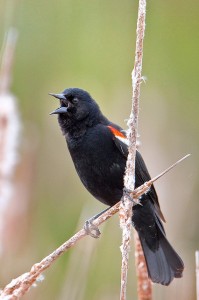The “Meaningless” Calls of Red-winged Blackbirds

“What does that sound mean?”
“What is that bird saying?”
Questions like these are an important entry point for many people into investigating bird behavior. One moment, they’re simply admiring a song, and the next moment, they’re noticing things — like a sudden switch to Sound B as a hawk flies over.
Once they’ve noticed it, they can hypothesize about it. Maybe Sound B means danger. Maybe the bird is saying, “Look out, there’s a hawk!” Maybe Sound B is the aerial predator alarm call.
When people start drawing inferences like this, they’re taking an important first step towards being investigators of animal behavior — ethologists — rather than mere admirers of it. It’s an exciting and significant moment in the relationship with nature.
But it’s only the first step. Most of us don’t have the time or the resources to take the second step, which is to methodically test whether our hypotheses are correct. If we did, we’d often have to face the fact that we were wrong.
Red-winged Blackbird alarm calls
What does a male Red-winged Blackbird say when a hawk flies over? Well, it could be any of these wildly different sounds:
It could be any of those sounds and a whole lot more. In fact, it’s very difficult to predict what a Red-winged Blackbird will say in response to a hawk.
A budding ethologist might think this a little strange. Doesn’t a huge variety of “aerial predator alarm calls” risk confusion? Any blackbird who doesn’t get the message could be easy prey — so evolution would seem to favor a single alarm response that all members of the species “agree on,” so to speak.
One possible explanation is the existence of local dialects. Perhaps the Redwings in this particular marsh give a high downslurred whistle when a hawk appears, but the Redwings in the next marsh over give a three-noted “ti-ti-ti“. The form of the call might depend on location, just as human alarm calls sound like “look out!” in New York, “pas op!” in Amsterdam, and “abunai!” in Tokyo.
Makes sense. Redwings do have local call dialects. The ones in this marsh do sound different from the ones in that marsh. But even that doesn’t explain the plethora of responses.
In a study published in 1986, Les Beletsky, B.J. Higgins, and Gordon Orians tested the responses of male Red-winged Blackbirds to a stuffed Cooper’s Hawk. They already knew that each Redwing in their study area gave seven different calls, which they called”peet”, “check”, “chuck”, “chick”, “chonk”, “chink”, and “cheer”. They revealed the stuffed hawk to 32 calling male blackbirds, 21 of which quickly switched call types:
One male switched to “peet” upon detecting the hawk, 4 males switched to “check”, 4 switched to “chuck”, 3 switched to “chick”, 2 switched to “chonk”, and 7 switched to “cheer”.
To be clear: all the male blackbirds could give all seven calls. When they saw the hawk, they switched to a different call from the one they had just been giving. But Beletsky et al. realized that which call type they switched to didn’t matter. That’s because it was not the call itself but the change in calls that sent the alarm signal:
Male redwings apparently use call switching as a component of a general alert system. … Individuals shift from one call to another when detecting environmental changes such as the appearance of a predator or the sudden movement of an observer. Even a stone tossed into a male’s territory can elicit from him a call switch and contagious switching around the lake. When detecting a call change by one male, the predominant response of other males is to switch to the same call type. The new type then supercedes the previous one as background, upon which subsequent call switches can be detected and localized, i.e., the system is immediately “reset” to a receptive status, awaiting the next change to impinge upon it.
This alert system is a highly effective one, but it only works in Red-winged Blackbirds because a few specific preconditions are met:
- Red-winged Blackbirds nest in dense colonies where many nests are simultaneously vulnerable to the same predator, and communal vigilance benefits the entire group;
- Male Redwings are exceptionally vocal, calling nearly continuously throughout the day, rarely stopping for more than a minute at a time;
- Individual males have large repertoires of different call types, learned from and shared with neighboring males;
- All males are quick to match a neighbor’s new call type right after he switches.
This remarkable behavioral system demonstrates how wrong our anthropomorphic assumptions about communication can be. It’s tempting to think of bird sounds as though they were words and phrases, as though it were always the form of the sound that encoded specific messages to the listener. But that’s not how Red-winged Blackbirds work. In and of themselves, their many “alert calls” may be practically meaningless. Instead, the “meaning” is carried by the relationship of a call to the ones around it in time and space — its position within the larger matrix of calling behaviors.
For me, at least, this study opened up a whole new way of thinking about bird communication.
2 thoughts on “The “Meaningless” Calls of Red-winged Blackbirds”
Great post! I think the point is similar to what I took away from “The Singing Life of Birds”. Often the “meaning” of bird vocalizations becomes clearer when you step back and look at the bigger picture rather than focusing narrowly on the structure of particular calls or songs.
Well put.
Comments are closed.